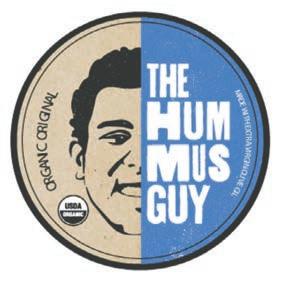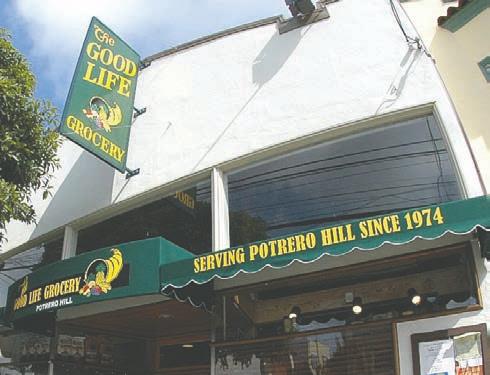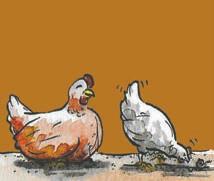




Forty-eight years ago, a group of Potrero Hill residents – artists, labor union activists, peaceniks – published Hills and Dales, a fledgling newsletter to inform neighbors about goings-on, and possibly even influence local politics. The mimeographed missive soon morphed into The Potrero View, the newspaper you’re holding in your hand or reading on a screen.
The View fulfilled its mission, and more. It helped elect Nancy Pelosi to the U.S. House of Representatives and Sophie Maxwell to the San Francisco Board of Supervisors, was integral to toppling the Hunters Point and Potrero power plants, and contributed to better transportation and land use outcomes. Meanwhile, it celebrated births, mourned deaths, illuminated stories about the community’s artists and merchants, and gossiped about new restaurants and bars.
Is it now “mission accomplished?”
Newspapers across the land are busy dying. Earlier this year, more than a half-dozen East Bay Times reporters, photographers, and editors accepted buyouts ahead of a round of layoffs, reducing the editorial staff by
one-quarter. People’s attention is now focused on social media, and ample access to on demand infotainment. Nextdoor feeds the need for neighborhood gossip; SocketSite tracks new building activities. Do we really need a monthly newspaper?
Chances are, having read this far, you’ll answer “yes!” The View continues to fill a niche that no other source occupies: substantive news and information about the people, places, and events influencing our community. No other media regularly covers what’s going on in our schools, with local merchants, and residents’ lives and deaths, among other neighborhood concerns. For many, the View provides an essential contribution to what makes Dogpatch and Potrero Hill special.
That the View is principally a print publication adds to its cache, but both attracts and repeals readers and advertisers. Some people don’t want to get their fingers dirty handling ink-stained copies; others cherish the ability to pass on published photographs of their loved ones to faraway relatives, and like the feel of print in their hands as they sip their coffee. Many advertisers see a value in the relationship a monthly print paper that’s directly delivered to

doorsteps has with its readers; others are focused on social media’s popularity and potential for laser-sharp targeting. In any event, there’s no Internet-based business model to sustain a geographicspecific publication that attracts well less than 50,000 readers a month. For now, anyway, the only way to survive is in print.
The paper isn’t in any immediate danger of folding, in part because of a willingness of its staff to work pro bono. But there’s been a sharp decline in advertising over the past couple of years, including by longtime merchants in the community who have been lured away, hopefully temporarily, by more sparkly marketing options. Reduced revenues has translated into fewer pages and less ambitious articles. In excellent months the View balloons to 40 pages. Lately we’ve regularly been half that. A 16-page paper would signal that finances have entered a stage that threatens long-term viability.
If you want the View to make it to its 50th birthday and beyond, considering doing the following:
In the wake of Mayor Ed Lee’s unexpected passing in December, a special mayoral election will be held on June 5, with the winner occupying the post until 2020. One of the frontrunners, Mark Leno, served two terms in the State Senate, from 2008 until 2016, representing the 3rd and 11th Districts, was a State Assemblymember from the 13th District, and, from 1998 to 2002, worked as District 8 Supervisor.
“I intend to shake things up,” Leno
Green Benefit District is a quasigovernment organization directed by a board of elected Dogpatch and Northwest Potrero Hill residents to help maintain and expand the area’s parks and greenery. The organization was formed in 2015, after securing 76 percent of property owner votes in the district.
GBD’s 15 directors – including a president, vice president, treasurer and secretary – oversee its programs and investments. Occupants of the four officer positions are selected by the board. Each spring, an election is held for five seats. This year’s poll is open until March 26. According to Jean Bogiages, GBD president, ballots were sent to 1,157 property owners in the district based on their address on file with the City Assessors Office.
“This is a neighborhood board, so I think folks are interested in selecting
neighbors who they can communicate with, who are capable, and who will do a good job carrying out the mission of the GBD,” Bogiages commented.
The five seats are open to two Dogpatch property owners, one Dogpatch tenant or property owner, one Northwest Potrero Hill property owner and one Northwest Potrero Hill tenant. Registration for candidacy ended midFebruary. Each position is for a threeyear term, with a two-consecutive term limit; a person may run again after a year break.
Seven candidates are seeking board seats, including three incumbents: Robert Broucaret, James Naylor and Kate Eppler, who currently serves as secretary. Broucaret is a Northwest Potrero Hill property owner who has professional horticulture experience. Naylor is a Dogpatch property owner who works in management at the
The San Francisco Police Department is fielding foot patrols at Jackson Playground… The proprietors of Pera Restaurant are now running the eatery located just around the corner, Papito, as well as the venerable Cha Cha Cha in the Mission…speaking of tasty, Florida-based The Spice Lab is vending Olive Oil Herb Blend – red peppers, garlic, oregano, and sea salt – that has a yummy smoky flavor. Also on offer are Tequila Salt Shooters, with an insert that keeps the beverage from getting too salty.
Let There Be Giants
The San Francisco Giants’ 28-acre development at Mission Rock won unanimous support from the Board of Supervisors last month. The project was approved in a nine to zero vote, with Supervisors Ahsha Safai and Malia Cohen absent. Mission Rock is emerging on a Port-owned patch of land, with eight acres of open space, 1.5 million square feet of retail and offices, and up to 1,500 housing units, 40 percent affordable to low- and moderate-income people… Also in February, Board of Supervisors president and mayoral candidate London Breed, as well as Cohen, endorsed Theo Ellington’s campaign for Cohen’s District 10 seat.
Bombs Away!
The San Francisco District Attorney’s Office wants people to register their security cameras, as a means to deter crime and promote public safety: http://sfdistrictattorney.org/registeryour-cam... If you’re jittery about the possibility of nuclear attack from North Korea, Russia, or a terrorist organization, it may be time to return to the days of do-it-yourself bomb shelters. San Francisco doesn’t have any special fallout refugees; the basic advice is to stay indoors. Who’d have thunk the idea of digging underground accommodations to safeguard against the atomic apocalypse would come back in vogue. What’s next, a fear-based baby boom? Poodle skirts?
Fun Consequences
Seen on Valencia Street on a weekday morning: a mom and her preschoolaged daughter scootering down the
sidewalk. “Watch this!” called out ma, as she attempted, and flubbed, a quarter-inch jump over a water meter cover. “You did it wrong!” shouted the girl, as she gleefully executed her own eighth-inch vault. “Wheeeeee!” A few blocks later, the child was crying shrilly in her mother’s arms, felled, no doubt, by her own exuberance. What lesson did she learn from the experience? No pain, no gain? Better safe than sorry? Roll on a crack, hug your mother back?

Editor,
The February piece the View ran in its Short Cuts section about Tacolicious’s new no-straw initiative was great, but it didn’t tell the whole story. You state that we’ve replaced our plastic straws with paper ones. In actuality, we’ve eliminated plastic straws entirely and paper straws are now available only by request, barring a few specialty drinks. We think to make a real impact, a no-waste program is essential. Hot tip: request a margarita with a half-rim of salt for the best kind of no-straw margarita drinking.
Kory Cogdill Public Relations + Community Manager Tacolicious Management, Inc.Last fall, the late Mayor Ed Lee announced that this winter San Francisco would help an additional 1,000 homeless people secure shelter. However, according to Jeff Kositsky, head of the Department of Homelessness and Supportive Housing, as of last month only about one-fifth of the hoped-for extra spots in the City had been created. Kositsky explained that another 411 beds are in the works, including at a new Navigation Center slated for Fifth and Bryant streets.
“Our department has been working tirelessly to meet this challenge, and have already placed about 200 people through new programs and projects that did not exist prior to Mayor Lee’s challenge,” said Randolph Quezada, DHSH spokesperson.
Existing facilities at 1515 South Van Ness and 1950 Mission Street are expected to close by this summer. If no additional capacity is created before then there’ll be a net gain of just 150 shelter beds in San Francisco.
Frustration over the lack of progress to address homelessness was evident at the San Francisco Board of Supervisor’s Public Safety and Neighborhood Services Committee meeting last month, at which District 8 Supervisor Jeff Sheehy questioned Kositsky about whether it “…made sense to uproot people from their communities, even if they’re tents on the streets, for a short period of time and then dump them back on the streets, where they have to start all over again…”


In response, Kositsky stated that “…most encampments are awful places…” in which “four out of five women report being victims of sexual abuse.” Other communities have been able to enlarge their shelter capacity faster than San Francisco. Prompted by a Hepatitis A outbreak in San Diego last summer, 700 additional beds were made available within six months. During a February visit to San Diego, the View came across an individual relaxing and reading a book in their newly installed shelter bed, their belongings securely stored underneath. A similar scene had previously been spotted in San Francisco: a woman sitting on the sidewalk with her legs stretched out
reading a book, in this case in front of three makeshift tents located on a busy corner near an overpass.
San Diego had been preparing to expand its bed capacity even before the Hepatitis outbreak. But that city’s model appears to be nimbler than San Francisco’s, principally relying on large tents and bathroom trucks in contrast to the Navigation Center approach, which typically requires semi-permanent construction. This may also be one of the reasons that San Diego’s temporary shelters cost less than half of San Francisco’s, $43 per resident per day compared to $90 per resident a day.


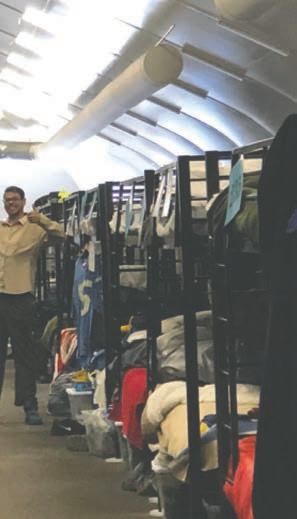
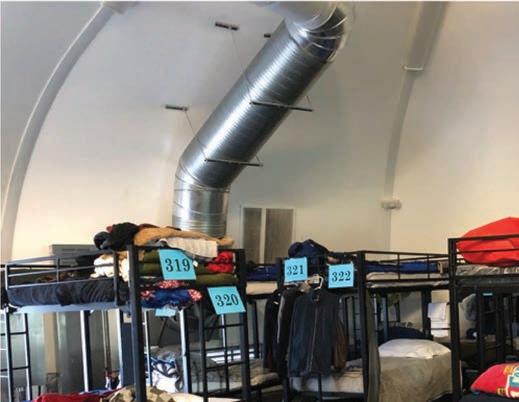


Last month, the San Francisco Planning Department released a final version of the Central Waterfront Public Realm Plan, reflecting an 18-month effort to synthesize municipal and neighborhood land use aspirations into one guiding document.
The plan takes a comprehensive look at the waterfront and Dogpatch east of Pennsylvania Street and north to south from Mariposa Street to Islais Creek. Included are proposals for redesigns of Tunnel Top Park, Esprit Park and Warm Water Cove, extensive beautification efforts and street connection improvements, particularly for pedestrians and bicyclists, from Potrero Hill to the Bay.
“We know Dogpatch needed a holistic vision, and that is what I think we have with this public realm plan,” said Robin Abad Ocubillo, Planning Department project manager. He cited three main principles guiding that vision. “What we want is a network of complete streets, a diversity of high quality open spaces and a landscape that expresses Dogpatch’s unique history and character,” he explained.
While some plan elements are in the idealist stage, others are already underway. A new conceptual design of Esprit Park has been approved by the Recreation and Park Department. With
an aim to maintain the park’s forest feel, changes include more defined entrances, reconfiguring the lawn to have greater amounts of usable square footage, and redefined paths for improved circulation. With $5 million committed from the University of California, San Francisco after two student housing developments were proposed nearby, and another $2.7 million allotted from impact fees paid by developers, construction is slated to begin after environmental review is complete.
Also with funding primarily from impact fees, building began in January on the 22nd Street Green Connection, which will link open spaces from Illinois Street to the Caltrain station at Iowa Street. The project, which involves tree plantings and street and sidewalk improvements, will be completed by the end of this summer. In the future, the connection may extend to Warm Water Cove, at the end of 24th Street, and up the hill to the Potrero Hill Recreation Center. The Port of San Francisco has reserved 2.5 acres to the south of Warm Water Cove for further expansion but, despite designs being included in the realm plan, Ocubillo said it’s not likely to be a priority until there’s more of a residential presence in the area.
The 22nd Street Connection is one of several that began with a neighbor-
WATERFRONT continues on page 17
In January, Bauman Landscape and Construction, Inc., a contractor for the Department of Public Works (DPW), began work on the “22nd Street Green Connection” project, a collection of improvements intended to enhance pedestrian traffic in the area. The undertaking is expected to be completed by the end of this summer.
The work currently focuses on the areas between Pennsylvania Street and the Caltrain bridge, and from Illinois to Third streets. “Once each of these segments is complete, (Bauman) plans to move to the next block. We estimate approximately two months per block for the major work; sidewalk, bulb-outs, street base, sewer work. Above-ground elements of the streetscape – planting, irrigation, pavers – would follow afterwards. Finally, the roadway,” said Kelli Rudnick, DPW project manager.
According to Rudnick, the goal of the 22nd Street Green Connection project is to create environmentallyfriendly links between Illinois Street and the Blue Greenway, San Francisco Bay Trail, and future development and open space to the 22nd Street Caltrain station at Iowa Street, up the hill to the Potrero Hill Recreation Center.
The Blue Greenway is an emerging network of parks, trails, beaches, and Bay access points along 13 miles of the
City’s southeastern waterfront. The San Francisco Bay Trail is a bicycle and pedestrian track that’ll provide uninterrupted travel around the Bay’s coastline; 354 miles have been completed so far. Future parks in the area include the eventual opening of Crane Cove Park, between 19th and Mariposa streets; renovation of Shoreview Park, at 1 Lillian Court between Beatrice and Rosie Lee lanes; and modifications to India Basin Shoreline Park, located between Hunters Point Boulevard and Hawes Street. Expected development consists of housing and commercial space at Mission Rock, Pier 70, India Basin, the Hunters Point Shipyard and Candlestick Point.
“All of these elements are designed to enhance this vibrant Dogpatch commercial corridor and strengthen the connection for people walking, cycling and taking transit,” said Rudnick.
Planned changes include roadway repair and restriping, asphalt repaving, and new curb ramps. Bulb-outs will be installed at 22nd and Pennsylvania street’s northwest and southeast corners, 22nd and Minnesota street’s northwest corner, 22nd and Tennessee street’s southwest and northeast corners, and 22nd and Third street’s northwest, southwest, northeast, and southeast corners. The City will also
22ND STREET continues on page 18
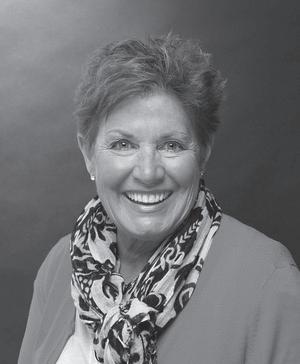


Enlarging Islais Creek by 300 acres, moving the Southeast Wastewater Treatment Plant to the waterfront, and turning Interstate-280 into a pedestrian sky park are among the ideas being considered by a team of urban planners, architects and ecologists studying ways to adjust to potentially rising sea levels.
Islais Creek is one of 10 Bay Area sites chosen to be part of the Resilient by Design Bay Area Challenge, an initiative primarily funded through a $4.6 million grant from the Rockefeller Foundation to develop creative and long-lasting solutions to the impacts of climate change on the shoreline. According to U.S. National Oceanic and Atmospheric Association, sea levels in San Francisco Bay may rise by one foot by 2040 and 3.5 feet by 2080.
The team studying Islais Creek consists of two international urban design and architectural firms, Danishbased Bjarke Ingels Group (BIG) and Netherlands-based One Architecture, as well as San Francisco’s Sherwood Design Engineers. The group started studying Islais Creek last September. The team’s proposal was chosen in January by Resilient as one of the finalists funded to create a design plan, which’ll be unveiled this May, just prior to Governor Jerry Brown hosting the
Global Climate Action Summit in San Francisco.
Resilient received 51 applications in all, including five others focusing on San Francisco sites: Mission Creek, Fisherman’s Wharf, Crissy Field, Fort Baker and Treasure Island. Islais Creek was the only San Francisco location chosen.
According to Bry Sarte, a Sherwood engineer, Islais made the most sense to examine as a San Francisco site. “We identified Islais as a place where we can make a really positive impact. It seemed to be the most complex, interesting and regionally replicable,” he explained. “It also has been at the heart of environmental injustices, and a place that needs to be thoughtful to the community.”
Part of the Challenge’s charge is to look beyond coastline solutions and address where climate change intersects with social infrastructure issues, such as housing, transportation and income inequality. The Challenge is modeled after a similar effort undertaken in New York and New Jersey as part of the recovery from Hurricane Sandy in 2012. BIG was involved in that effort.
According to Jeremy Alain Siegel, a senior designer for BIG, one of the places his team used as a pilot was New York City’s Lower East Side, which has
ISLAIS CREEK continues on page 21
A showroom and retail building located at 300 Kansas Street, on Potrero Hill’s northern end, may be transformed into a modern structure, if a preliminary proposal moves forward. Developer Group i recently submitted an application to the Planning Department that proposes to demolish the existing production, design, and repair building and construct a new six-story PDR building on the 27,500 square foot PDR-zoned lot. The parcel is bounded by Kansas, Vermont and 16th streets. According to Planning staff, the application won’t likely be reviewed for several months.
“We just submitted, so the process is still in the very early stages,” said Leigh Chang, director of acquisitions, Group i. “There are a lot of small industrial PDR buildings in the area, and we want to come up with something that’s more modern PDR, not something old or antiquated. We’re hoping to create a more 21st century PDR building, but still keep with the character of the neighborhood; something innovative that serves the community.”
Group i purchased the property in 2016 for $14.2 million from a private investor. The company is working


616 CAROLINA @ 19th Street $2,249,000
Please visit www.MillValleyonPotrero.com
Incredibly rare opportunity to own a Million Dollar View with deeded air rights! This Japanese-inspired 3-level home is a true urban retreat, tucked away on one of Potrero’s most coveted tree-lined blocks. Cathedral-ceiling living room with frplc and views, custom kitchen and remodeled baths, enormous top-level Master Suite with frplc, private deck and direct Downtown VIEWS! A first-floor bedroom suite and 4th bdrm/o ce provide opportunity for flexible use. Beautiful hardwood floors, serene wooded garden, laundry room, large garage with storage. Accessory unit in rear garden o ers potential and flexibility! Quiet block with no through tra c; prime location between 18th & 20th Street shops, co ee & restaurants. Opportunity of a lifetime!
with architect El Dorado Inc., which produced a conceptual plan for a 68 feet tall building that provides 137,500 square feet of space, of which 112,192 square feet would be rentable, with the remaining used for common spaces and exterior open areas. A basement garage accommodating 61 vehicles would be below six above-grade levels and a roof deck.
According to Josh Shelton, El Dorado Inc. principal, his firm strongly believes that there’s a place for PDR uses in the urban core. He said his firm has extensive experience in planning light industrial facilities, and has been working on the design for 300 Kansas Street for more than five months.
One project goal is to allow for high quality interior lighting, which would be achieved by utilizing transparent and translucent polycarbonate materials that reduce glare and diffuse light. Shelton described the design of the building’s facade along 16th Street as having a quality akin to a glowing lantern, making it appear as a beacon, bringing a feeling of warmth to the neighborhood, in contrast to the common coldness of older industrial structures. He expressed a desire for
300 KANSAS continues on page 22
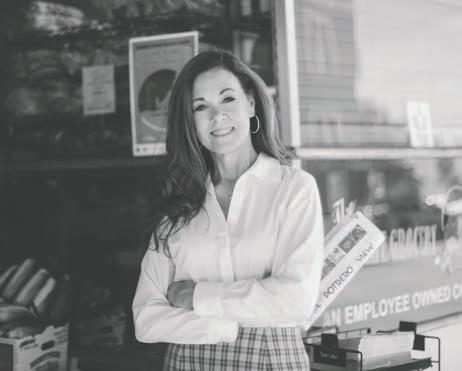
Your Agent for Good.
e-Pro, SRES
415.336.0754 | melinda@melindalee.realtor
Lic. #01344377 melindalee.realtor
MARCH is traditionally the spring market kick-o , with multiple o ers and climbing prices.
I’m working with homeowners NOW on how to prepare for the market. Let’s arrange a walk-through of your home, at no obligation. I’m here to help.

Potrero Hill Coin Laundry went out of business last fall, ending 18 years of laundromat service. Its departure from a central location in the neighborhood, at 1310 18th Street, leaves a void for community members who lack access to machines at home, and don’t have the funds to pay for more expensive services. Although the dearth of coin-operated laundry businesses is especially acute in Potrero Hill, it’s part of a greater trend of coin-operated laundries folding across San Francisco and the country.
Hoodline, using archived Yellow Pages, compiled data from the last 50


years and found that the number of laundromats in the City declined by 59 percent over the last two decades, and dropped by 82 percent since 1966. Author Shane Downing was uncertain as to the cause.
“We can’t say whether the decline in laundromats in San Francisco is because of lower demand, higher rents, or something else, but one present day theme exists: current and former laundromats are quite visibly being converted into restaurants,” he wrote. “Because laundry facilities are equipped with the requisite ventilation, gas, electricity and plumbing utilities
LAUNDRY continues on page 20
Professional Wet Clean Laundry & Alteration We Do Wash & Fold

TEL: (415) 647-8080
600 VERMONT ST. & 18TH ST. SAN FRANCISCO, CA 94107



“I make people beautiful. When they’re happy, I’m happy,” said Teresa Do, owner of La Fleur Hair & Nail Spa, on 20th Street. Do, who immigrated from Ho Chi Minh City, Vietnam, lives near Bayshore Boulevard. She opened her salon on Potrero Hill because she likes the neighborhood, and had been a stylist in the area.
Do worked as a cashier, bookkeeper, and dental assistant before attending cosmetology school in Hayward. She opened La Fleur in 2015, in a space that’d previously been home to Michael Gary and Company. The salon’s large, bright, welcoming main room features numerous hair and nail stations, WiFi, with a variety of hair and nail products on offer. It has yellow walls, smooth hardwood floors, red and white polka dotted cushions, and zebra stripe accents. Fresh flowers and green plants are sprinkled throughout the space. “I did all the decoration,” smiled Do.
La Fleur offers haircuts for men and women, manicures, pedicures, other nail services, and waxing. According to Do, the most popular item for men is haircuts. Women prefer “long hair layering,” highlights, and coloring, as well as gel manicures in metallic colors. In addition to Do and her daughter, Sharon Hang, who answers the phone, six other individuals work at La Fleur.
Customers are offered tea and cookies while they wait for or receive services.
Do also makes house calls, particularly for her elderly customers, providing in-home haircuts, manicures, and pedicures to those who have trouble getting around. “I just help my friends, anyone who has physical problems. I love to help people,” said Do.
Manuel Pappas, a resident of the 700 block of Kansas Street, said Do’s home visits benefit his mother, Mary Pappas. “She’s 92 years old and she’s not mobile. Every two months, Teresa does a house call, often a haircut, sometimes a pedicure. The house calls were Teresa’s idea,” said Pappas.
Potrero Launch resident Amy Edwards has been coming to La Fleur for the past three years because “these ladies are like my family. I’m always welcomed with open arms and hugs and kisses. They’re extra hospitable. Often Teresa offers to drive me home or come pick me up. It’s just the attention to detail you see here.”
Edwards plans to move to Seattle. She’ll return to the City frequently for business; when she comes, she’ll continue to get haircuts at La Fleur.
Mission Bay resident, Regina Anavy, said she likes La Fleur so much “that I don’t even live on the Hill but I come up there to see Teresa. I just like her personally. She gives good haircuts
LA FLEUR continues on page 18













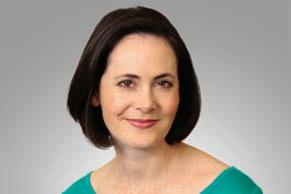


































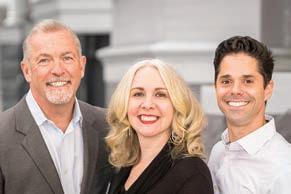




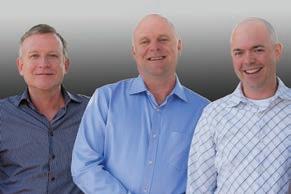














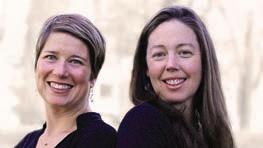







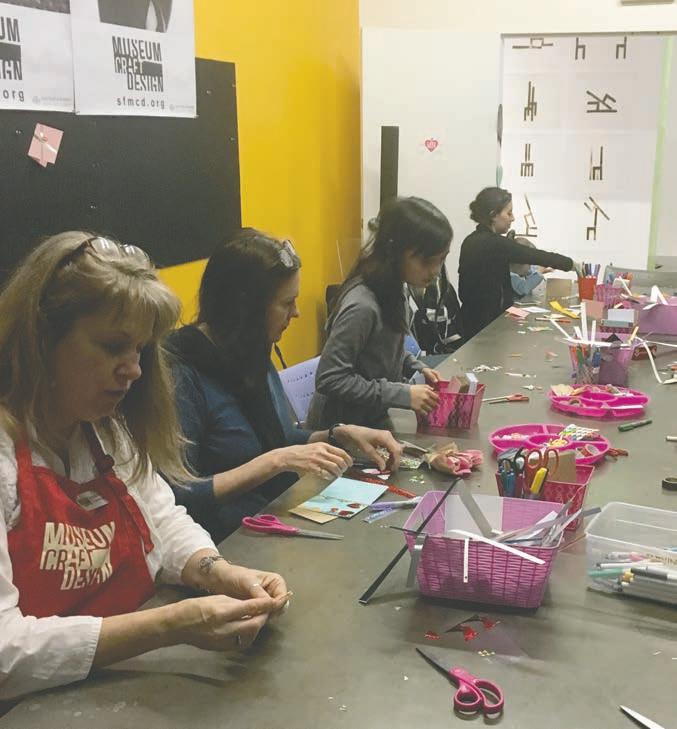
Last year, the View reported on a Honey’s of the Hill calendar fundraiser spearheaded by Lorys Crisafulli, Dorene Cotter and Sally Taylor, Potrero Hill Neighborhood House Senior Lunch program participants. Inspired by the 2003 movie, Calendar Girls, the three worked with Nabe staff to create and sell calendars that featured a dozen local seniors posing as “the ladies who lunch,” playing on the film’s “pin-up girl” theme. As part of the marketing effort, Crisafulli, Cotter and Taylor donned costumes befitting the subject; calendars were sold for $15 each.
The effort generated more than $11,000 from advertisements and contributions, of which $7,500 was dedicated to scholarships for local young adults pursuing post-secondary education. The rest covered calendar production costs.
“We all had a good time posing and laughing at ourselves,” expressed Crisafulli. “Sally and I spent many fun times selling the calendars; I loved every minute we spent on it. The women involved are all well-known and did it for a good cause.”
“The idea was to help these youth get through the process of getting an education, and we had a wonderful experience doing it,” said Taylor. “I enjoyed getting to know people in the neighborhood, and it was a pleasurable experience in terms of reaching out to the community. People were so generous; some gave $20 and wouldn’t even take the calendar. So many people want to help, but it can be difficult to connect the help with people in the community who need it the most.”
The fund was divided into twelve $500 scholarships to help pay for
schooling expenses beyond tuition; the remaining $1,500 covered the Nabe’s costs associated with administrating the scholarships. Following a round of applications last spring, grants were awarded at the nonprofit’s annual Moms, Dads and Grads celebration, which falls between Mother’s and Father’s Day.
“It’s a good thing for our Moms, Dads and Grads celebration,” said Edward Hatter, Nabe executive director. “There’s a meal, entertainment and then the scholarships are presented. We plan to do another one this year, making the scholarship awards part of the event.”
Out of a pool of five applicants, three were awarded scholarships last year. Jamion Wright, a 2017 Mission High School graduate, attends California State University, Sacramento, where he plays basketball and is planning to major in business. The funds helped Wright with food expenses. Shatonya Amerson goes to City College of San Francisco, and used her scholarship to purchase books for her freshman year. The money aided Mariah Sapp with basic living expenses to get through her final year at San Francisco State University. After graduating in January, she applied to law schools with the hope of matriculating this fall.
“Finding money for books and other extra expenses have always been the biggest problem for our young people in school,” Hatter explained. “After paying for housing and tuition, they’re broke, and it’s a strain on them, especially in the freshman year.”
With nine scholarships unclaimed, the Nabe is accepting applications for another round of awards from now until the end of April. Similar to last year, neighborhood residents who are
enrolled in any kind of post-secondary educational program can apply. Crisafulli expressed hope that young people attending a trade or vocational school will be considered for the funds, commenting that monetary assistance is often limited to college attendance.
The application process involves submitting an essay, answering questions about educational pursuits as well as recent grades. Awards will be presented at this year’s Moms, Dads and Grads event scheduled for May 24
“Why humanity? Not whence we nor whither we, but why we?” asks the back cover of The Harmonics of Unity, a new book by Harold Terry Lindahl. The volume deploys a complexity of words, schematics, and creative images to explain the interactions of art, science, and religion, based on insights from Albert Einstein, Charles Darwin, and George Ivanovich Gurdjieff.
There might be no better time for an attempt at understanding the why of humanity, as society struggles under the weight of a cascade of just-in-time true or false information bits and the destruction, or reconstruction, of cultural cohesion. According to Lindahl, self-examination and the quest to comprehend larger meanings have been overwhelmed by a technological examination of phenomena. “Nowadays, self-knowledge has been reduced to knowing what I like and don’t like, red or blue, Chevy or Ford,” Lindahl said.
The Harmonics of Unity posits that the “…haunting resonance of the Gnostic question Whence We Why
from 5:30 p.m. to 7:30 p.m. at the Nabe.
“We need to identify more applicants for this year,” Taylor said. “The more people that apply, the more qualified students they will be able to award the money to. We need more support from neighbors who know of people in need of financial assistance for school. The Nabe is tight on resources and needs help finding recipients for this year.”
For more information about the scholarship: 415.826.8080.
and Whither We, has recently become tractable. The record is clear, the universe is functioning just as it must, and humanity, through its probative instincts, is scanning geo-bio-cosmic realms for information, just as it must.” Its observations are based, in part, on the second law of thermodynamics, which states that the universe is a “closed system” subject to entropy, or the increased loss of energy or vibration rate. As Erwin Schrodinger stated in 1944, “Life feeds on a flow of negentropy,” and negentropy results from the processes of life.
The book’s artwork – which has the feel of a mashup between math, biology, and an inside look at the cosmos – is meant to convey the dynamics of the human condition. Whether or not they are effective as communication devices, the images are beautiful in their diversity of shapes, textures, and depths.
The Harmonics of Unity is available at Christopher’s Books, Farley’s, and online booksellers. Workshops, free and open to the public, exploring its themes will be held on March 13, 20 and 27 at 7:30 pm, 312 Connecticut street.




Dogpatch


Movie and a Meal
In partnership with the Potrero Hill Family Support Center (PHFSC), we’ll present a family-friendly film, and PHFSC will provide a meal. Our selection for March is The Mighty Macs. Friday, March 16, 3 to 5 p.m.
Make a Magnet Featuring Rad Women
Celebrate National Women’s History month by making a magnet or button of your favorite woman in history. We’ll have images on offer, or can help you use your own image without damaging the original. Saturday, March 17, 3:30 to 5 p.m.
Painted Garden Rock Markers
Now that spring is here, make your garden more beautiful with these homemade garden markers. Let your artistic side shine as you paint your own garden markers. All materials provided. Wednesday, March 28, 3 to 4 p.m.
Make a Washtub Bass
The washtub bass is fun to build and easy to play. Tools and materials provided. Bring your own metal washtub or any size of metal or plastic bucket. (cleaned paint cans OK!) or use one provided; supplies may be limited. Sunday, March 4, 2 to 3 p.m.
Saturday Snacktivity
With food provided by The Good Life Grocery, we’ll offer a wholesome snack and fun activity. All ages welcome. Saturdays, 11 a.m. to 12 p.m.
Baby Rhyme and Play Time
Songs and rhymes for infants up to 18 months old and their caregiver(s). Tuesdays, 1:15 p.m. and Thursdays, 11:15 a.m.
Toddler Tales
Books, rhymes, music, movement and more for toddlers 18 to 36 months and their caregivers. Thursdays, 10:15 to 11 a.m.
Puppy Dog Tales
This ongoing SPCA program pairs trained dog-and-owner therapy teams with kids to grow children’s literacy, self-confidence, and socio-empathic skills. Your child will adore reading to this calm canine companion in a non-judgmental setting! For ages four to eight but older welcome. Saturdays, March 3 and 24, 12 to 1 p.m.
If you wake up later this month to the sound of bagpipes, it can only mean one thing: our anniversary.
This St. Patrick’s Day, we celebrate 29 years at the heart of Potrero Hill. Stop by for all the festivities!
farleysco ee.com
1315 18th St (@Texas) | 415-648-1545




Potrero Terrace and Annex residents consistently point to community violence as their chief concern and stressor. Research tells us continual exposure to and experiences of community violence can have adverse mental health effects—e.g., PTSD, depression, anxiety and fear. It can also lead to longer-term behavioral problems and lower levels of physical activity, particularly in youth, for example, if parents do not allow their children to walk to school or play outside due to safety concerns. Lastly, community violence can negatively impact social interactions and community cohesion, inhibiting residents from gathering together.
A MONTHLY UPDATE
SPONSORED BY BRIDGE HOUSING
We asked residents about their perceptions of safety—in their apartments and their neighborhoods and at different times of the day—both daytime and nighttime. Here’s what they’ve shared:
VOLUME 90 • MAR 2018
Potrero Terrace and Annex residents consistently point to community violence as their chief concern and stressor. Research tells us continual exposure to and experiences of community violence can have adverse mental health effects—e.g., PTSD, depression, anxiety and fear. It can also lead to longer-term behavioral problems and lower levels of physical activity, particularly in youth, for example, if parents do not allow their children to walk to school or play outside due to safety concerns. Lastly, community violence can negatively impact social interactions and community cohesion, inhibiting residents from gathering together.
BRIDGE Housing conducted a household survey in 2016 to inform the relocation planning process and services provision for Potrero Terrace & Annex (PTA) residents. Through a series of articles, we will share the findings. The focus this month is Safety.
Overwhelmingly, 80% of residents reported their housing conditions were unsafe due to issues with overcrowding, mold, roach infestation, vermin, hazards, plumbing and sewage, etc. Some residents were concerned their poor living conditions were negatively impacting their health and the health of their children, especially those with asthma.
We asked residents about their perceptions of safety in the neighborhood.
We asked residents about their perceptions of safety—in their apartments and their neighborhoods and at different times of the day—both daytime and nighttime. Here’s what they’ve shared:
• 80% of residents reported their housing conditions were unsafe due to issues with overcrowding, mold, roach infestation, vermin, plumbing and sewage, etc.
Similarly, 72% reported feeling the neighborhood is “unsafe” during the nighttime with 51% reporting feeling “very” unsafe and 22% reporting feeling “somewhat” unsafe. During the daytime, however, concerns of neighborhood safety come down to an equal 50/50 split of residents feeling safe and unsafe.
• 72% reported feeling the neighborhood is “unsafe” at night. During the day, there is a 50/50 split of residents feeling safe and unsafe.
Perceived Safety in the Neighborhood during the Daytime and Nighttime (N=457)*
Overwhelmingly, 80% of residents reported their housing conditions were unsafe due to issues with overcrowding, mold, roach infestation, vermin, hazards, plumbing and sewage, etc. Some residents were concerned their poor living conditions were negatively impacting their health and the health of their children, especially those with asthma.
Perceived Safety in the Neighborhood during the Daytime and Nighttime (N=457)*
During the daytime During the nighttime

Similarly, 72% reported feeling the neighborhood is “unsafe” during the nighttime with 51% reporting feeling “very” unsafe and 22% reporting feeling “somewhat” unsafe. During the daytime, however, concerns of neighborhood safety come down to an equal 50/50 split of residents feeling safe and unsafe.
Perceived Safety in the Neighborhood during the During the daytime During the nighttime
SAFETY (cont.)
San Francisco’s network of neighborhood newspapers is threatened by Trump’s tariff on the major suppliers of newsprint. The Commerce Department slapped an overall tariff of 6.53%, beginning February on newsprint, but it’s “pretty much a guarantee” that the U.S. will impose preliminary countervailing duties of 15 to 25% adding as much as 50% to the cost of our newspapers, according to Forbes Magazine
We analyzed residents’ perception of safety during the nighttime by race/ethnicity, age, gender, household composition, and tenure. Here’s what we found:
We analyzed residents’ perception of safety during the nighttime by race/ethnicity, age, gender, household composition, and tenure. Here’s what we found: Examined by gender, female and male residents reported nearly equal, high levels of unsafety (both over 70%).
Interestingly, newer residents tended to report higher levels of non safety compared to residents who have been living at Potrero longer.
Residents of all races/ethnicities reported high levels of feeling unsafe in their neighborhood. Most affected were Hispanic/Latino and Black/African American residents.
Very Unsafe *Missing=26 Very SafeDon’t Know Somewhat UnsafeSomewhat Safe
More than 75% of 18–34 year olds and 35–54 year olds said they feel unsafe in the neighborhood at night. Residents over 55 years reported slightly lower levels of feeling unsafe (68%).
Residents of all races/ethnicities reported high levels of feeling unsafe in their neighborhood. Most affected were Hispanic/Latino and Black/African American residents.
According to SF Police Department (SFPD) data from 2010-2012 certain crime rates in the PTA census tract are higher than the City rate.
Nearly all households with children reported feeling unsafe in the neighborhood
• Violent crime per capita: 68.2 (PTA census tract) vs. 53.1 (City) per 1,000 people
Interestingly, the longer residents live in the neighborhood, the safer they feel. Or put another way, newer residents tended to report higher levels of unsafety compared to residents who have been living at Potrero longer.
• Property crimes rate per capita: 290.3 vs. 162.6 per 1,000 people
More than 75% of 18–34 year olds and 35–54 year olds said they feel unsafe in the neighborhood at night. Residents over 55 years reported slightly lower levels of feeling unsafe (68%).
Examined by gender, female and male residents reported nearly equal, high levels of unsafety (both over 70%).
In a letter to Commerce Secretary Wilbur Ross, both Democratic and Republican Representatives urged denial of the tariff on Canadian newsprint which “could accelerate the decline for an entire industry and may put small-market newspapers out of business.”
Nearly all households with children reported feeling unsafe in the neighborhood
• Thank the advertisers who support your local paper!
• Support the advertisers and mention the paper to the businesses you trade with.

Angela’s experience, drive, and passion to improve the lives of all San Franciscans is unmatched in this race. She will rise above the petty, divisive politics in City Hall and find solutions to the issues that affect all of us.
www.aliotoformayor.com

PTA residents consistently point to community violence as their chief concern and stressor. Research tells us continual exposure to violence can have adverse mental health effects—e.g., PTSD, depression, anxiety, and fear. It can also lead to longer-term behavioral problems and lower levels of physical activity, particularly in youth, for example, if parents do not allow their children to walk to school or play outside due to safety concerns. Lastly, violence can negatively impact social interactions and community cohesion, inhibiting residents from gathering together.
When we asked residents about what stresses them out and why they would consider moving out of Potrero Terrace and Annex, there was a resounding concern around safety—whether it be unsafe housing conditions due to mold, vermin, sewage issues or because of persistent neighborhood violence, specifically gun violence, drugs and burglaries in Potrero and the surrounding areas.
Safety is critical to community health and wellbeing. Creating a safer Potrero Hill will require citywide as well as neighborhood-level resources from SFPD, service providers, community members, and more.
“I would love to live where my son can grow without crime”
For more information: website: rebuildpotrero.com, e-mail potrero@bridgehousing.com
– PTA resident
“I only live here because I have no other choice, but hearing gun shots is very scary” – PTA resident
According to data from the San Francisco Police Department, from 2010-2012, the rate of violent crime per capita in the Potrero Terrace and Annex census tract was higher than the City rate:
68.2 vs. 53.1 per 1,000 people
Similarly, the property crimes rate per capita in the Potrero Terrace and Annex census tract was even higher than the City rate:
290.3 vs. 162.6 per 1,000 people
We love calling Potrero Hill our home. Over the past decade-plus, we’ve helped dozens of clients find their perfect spot on the Hill. It’s easy to sell the virtues of our beloved neighborhood, having lived and worked here ourselves for more than 20 years. This year, we are proud to annouce that we are Zephyr Real Estate’s TOP PRODUCING POTRERO TEAM OF 2017!
Safety is critical to community health and wellbeing. Creating a safer Potrero Hill will require citywide as well as neighborhood-level resources
Wes Freas REALTOR®








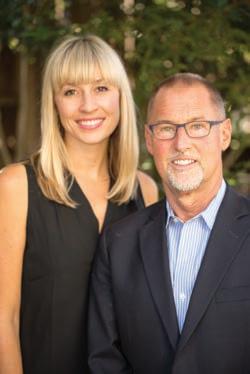
LIC# 013122854
415.518.6538
WesFreas@ZephyrSF.com
Wendy Watkins REALTOR®
LIC# 01854549
415.367.5997
WendyWatkins@ZephyrSF.com
WesandWendyHomes.com

Now through 3/3
Fashion: Goorin Brothers Sample Sale Goorin Bros., a fourth-generation, family-owned San Francisco-based company of bold hat makers, hosts a three-day sample sale at the company’s Howard Street headquarters. Hats starting at $15. 11 a.m. to 5 p.m. Goorin Bros., 1269 Howard Street. For more information: http://bit.ly/2EUznZQ
Now through 3/24
Theater: Revolt. She Said. Revolt Again. This provocative and darkly comic piece examines and decomposes language and other cultural constructs that restrict women in our modern world. In conversation with #MeToo, Revolt echoes the scandals that’re shocking our country, while wearily admitting that nothing’s shocking, and asks a familiar question: how do we even start to change circumstances for oppressed people, when that oppression is so deep that it imbues our very language? A darkly comic manifesto by Alice Birch, directed by Rebecca Novick, Revolt explores the ways women are pushed to fit society’s expectations. $15 (previews) to $30. Potrero Stage, 1695 18th Street. For more information and to purchase tickets: http://bit.ly/2jKlWD3
Dance: Rotunda Dance Series at City Hall
The Rotunda Dance Series is a set of monthly dance performances in San Francisco City Hall’s extraordinary rotunda. Dancers’ Group and World Arts West have partnered to bring audiences lunchtime glimpses into movement and musical traditions from around the world. Free. Noon. San Francisco City Hall, 1 Dr. Carlton Goodlett Place. For more information: http://bit.ly/1puaHVV
Music: Rocknrollfairy Music for kids and their grownups. 4 p.m. Farley’s, 1315 18th Street.
Art: Cory Evans
Check out this opening for a local artist. 7 to 9 p.m. Farley’s, 1315 18th Street.
Art: Shadows in Stereo
Shadows in Stereo is an analog, 3-D stereo imaging experience. Accompanied by a team of performers and dancers, artist Christine Marie uses handmade lights, simple objects, and wire sculpture to cast 30-foot shadows onto walls, ceilings, and floors, which appear three-dimensional when viewed with the appropriate eyewear.
6 to 8 p.m. Free. McEvoy Foundation for the Arts, 1150 25th Street, Building B. For more information: http://bit. ly/2ERj6F9
Community: San Francisco Street Parks Tour Street Parks are created when communities identify a space, develop a design, and raise funds to build them, often with support from the San Francisco Parks Alliance and San Francisco Public Works. The San Francisco Bicycle Coalition and the Alliance have teamed up for a tour of street parks, community-built spaces that include traditional parks, gardens, tiled stairways, and open recreation spaces. The tour will be approximately six miles on a bicycle, cycling at a comfortable pace; no one will be left behind. 1 to 4 p.m. Free. Meet at Tunnel Top Park, 1100 Pennsylvania Avenue. For more information and to RSVP (required): http://bit.ly/2Cc3efw

3/6,
Art: Tuesday Night Drawing Series Learn to sketch from a live model (clothed). Adults only. 6 to 8 p.m. $25 to $99. Arch Art Supplies, 10 Carolina Street. Class size is limited; details and sign-up: dcenter.org/arch
Film: Breakthrough: Portraits of Women in Science Celebrate Women’s History Month with an inspiring deep look at the pioneering work of women in science and technology on the big screen with Science Friday’s Breakthrough: Portraits of Women in Science. The acclaimed anthology will be shown in its entirety, followed by discussions with local women at the forefront of science, technology, engineering, and math innovation. Track polar bears in the arctic. Go inside India’s space agency. Discover the wonders of snail venom. Each Breakthrough episode takes viewers across the globe and inside the fascinating research of women who aren’t only pushing the boundaries of their respective fields, but challenging deeply-rooted cultural and institutional norms in the process. Afterwards, talk with women innovators about their work. Bring a future STEM leader; prepare to be riveted and inspired. 7 p.m. $15.25. New Mission, 2550 Mission Street. For more information and to purchase tickets: http://bit.ly/2EIKGoz
Music: Kevin Patrick McGee
Singer-songwriter Kevin Patrick McGee offers poetic, and occasionally amusing, original tunes that span genres, including alt-country, bluegrass, folk, and rock. 7 to 9 p.m. Farley’s, 1315 18th Street.
Community: City Hall Lights
In honor of International Women’s Day, San Francisco City Hall will turn its lights purple. 4 to 11:59 p.m. Free. San Francisco City Hall, 1 Dr. Carlton Goodlett Place.
3/8 through 3/11
Film: 15th Annual International Ocean Film Festival
The International Ocean Film Festival features more than 50 independent ocean-inspired movies from around the globe. IOFF screens the most current films that inform audiences about key issues affecting the ocean, and possible solutions to help protect it, while entertaining, educating, and engaging viewers to become ocean stewards. $8, children’s programs; $220 for festival pass. Cowell Theater, Herbst Pavilion, 2 Marina Boulevard. For more information, showtimes, and additional venues: http://bit.ly/2GxERaa
Music: Michelle Lambert and Robbie Original and Top 40 music, with influences from Amy Winehouse, Ed Sheeran, Adele, and The Red Hot Chili Peppers. 7:30 to 9 p.m. Farley’s, 1315 18th Street.
Performance: The Mission Youth Arts Fest Potrero del Sol Park becomes a high energy stage for the neighborhood’s finest youth performing groups. Young and old alike are invited to this outdoor festival that celebrates the voices and talents of young artists. Presented by Dance Brigade’s Dance Mission Theater, the event will feature performances by the dancers and taiko players of GRRRL Brigade, the sizzling samba drummers of Loco Bloco, the folkloric dancers of Cuicacalli, the buoyant musicians of Mariachi Juvenil La Misión, the martial artists of Abada Capoeira SF, the hip hop dancers of ODC Youth Program, the spoken word poets of Youth Speaks, Ruth Asawa San Francisco School of the Arts World Music and Dance, and more. Try a few moves during a mini dance class. Local youth groups will be on hand to provide information about their programs and youth services. Free. 1 to 4 p.m. Potrero del Sol Park, 2827 César Chavez Street.
3/10 and 3/17
Art: Urban Sketching
Artist David Tenorio will guide participants to learn urban sketching. Receive a handmade sketchbook, artist quality supplies, and study how to draw the world around you! $40 per person. Meet at Yerba Buena Gardens, 750 Howard Street. Get details and sign-up at dcenter.org/urban
Music: Daniel Berkman
Potrero Hill resident Daniel Berkman is a composer, multi-instrumentalist and innovator of the kora, a 21-stringed harp/lute from West Africa. 7:30 to 9 p.m. Farley’s, 1315 18th Street.
3/14 through 3/18
Performance: CounterPulse Festival
The inaugural CounterPulse Festival is a four-day celebration of mindbending performances. It’s both an incubator and launchpad for experimental dance and performance makers. Expect the perceptions and conceptions of yourself and those around you to flex as a full program of performance, conversation, and radical celebration unfolds over five days. $10 to $25. For more information and tickets: http://bit.ly/2sIBhYK
Art: MAKE
Introducing MAKE, a new after-hours event at the Museum of Craft and Design. On the third Thursday of each month, collaborate with artists and makers, explore creative themes and rethink materials through unique take-home projects. This debut event celebrates National Craft Month. SF Etsy will be on-hand to help participants find their inspiration. Play around with adhesive vinyl, as found in t.w.five’s current exhibition, and contribute to an in-gallery crochet bomb. Bring a friend and grab a craft beer while shopping at the MCD Store and visiting SF Etsy popup shops. Free with paid admission. 6 to 9:30 p.m. Museum of Craft and Design, 2569 Third Street. For more information: http://bit.ly/2BFQCfs
Art: Sofia Carmi
Opening reception and artist talk. 6:30 p.m. On view through 4/13; Monday through Friday 9:30 a.m. to 5 p.m. Italian Cultural Institute, 601 Van Ness Avenue, Suite F.
St. Patrick’s Day: Farleys
Farleys’ 29th Anniversary celebration.
Live music, Irish stew, and more. Free. 9 a.m. to noon. Farley’s, 1315 18th Street.
St. Patrick’s Day: Parade and Festival
The Parade begins at Second and Market streets, where more than 5,000 participants from all over America will reel about with laughter and revelry to City Hall, where the festival will take place. The colorful festivities will showcase Irish culture through live performances and entertainment, arts and crafts exhibitors, food and beverage concessions, children’s rides and inflatables, and nonprofits’ booths representing the Irish community.
Parade begins at 11 a.m. Festival hours: 10 a.m. to 5 p.m. Free. For more information: http://bit.ly/1WkQOSO
Science: California Academy of Sciences
For Dogpatch and Potrero Hill residents, with a driver’s license or other proof of residency, save $34.95 and visit the museum for free. Visiting adults may bring up to six children for free entry. California Academy of Sciences, Golden Gate
Park, 55 Music Concourse Drive. For more information and valid zip codes: http://bit.ly/2BLbq54
Music: Dream States
Acclaimed nine-man Bay Area vocal ensemble, Clerestory, is proud to present the final concert in its twelfth season. Dream States explores music tuned to different states of consciousness, in ways both whimsical and philosophical. Featured works include Gregorian chants and classic lullabies, as well as contemporary pieces by Eric Whitacre and David Conte. Clerestory also shines a timely spotlight on female composers, including Pulitzer Prize finalist Augusta Read Thomas and the Bay Area’s Minna Choi. 4 to 5:30 p.m. $5 to $25; prices increase by $5 at the door. St. Gregory’s Episcopal Church, 500 De Haro Street. For more information and to purchase tickets: http://bit. ly/2GtQzTi
Music: EJ Mathews Band
Voted breakout artist of the year for 2017 by Living Blues magazine. 7:30 to 9 p.m. Farley’s, 1315 18th Street.
Science: San Francisco Bay Area
Science Fair Public Viewing Day
See what local students have dreamed up, concocted, constructed, and proven with real science, and those trusty tri-fold poster boards, during a special public viewing day, part of the 2018 Golden Gate STEM Fair. 10 a.m. to 4 p.m. Free. Hall of Flowers, 9th Avenue and Lincoln Way. For more information: http://bit.ly/2EYVKNN
Music: James Everett
Rhythm and blues, jazz, and pop singer. 7:30 to 9 p.m. Farley’s, 1315 18th Street.
Benefit: The Great Pirate Treasure Hunt Pirates, seafaring folk, and even landlubbers are invited to play in the Pirate’s Treasure Hunt, benefiting 826 Valencia. Legend has it that there’s a cursed treasure hidden somewhere in the Mission District. Teams must solve clues, travel to hidden spots, participate in challenges, and find unique people, places and murals to locate the treasure and dispel its curse. Teams of two to six players will race throughout the Mission District to find the items/people/places in the Pirate’s Treasure Hunt List and win the Treasure Chest of prizes. Proceeds donated to 826 Valencia to fund writing programs for children. From $20. 1:30 to 4 p.m.; check-in begins at 1:30 p.m. Mission Pool, 3564 19th Street. For more information: http://bit.ly/2HD21NM

Potrero Hill is populated with artists working in a diverse range of mediums, including painting, itself host to a variety of styles and content. Hill resident Sofia Carmi focuses on abstract expressionism. She settled in the City 33 years ago, living in the original Serta Artist Building before moving to her current home at Goodman 2, a live/work artist community.
For Carmi, abstract art is a mix of “memory, mystery, color, form and texture” that captures the viewer, forcing an interpretation not immediately apparent. An Israeli native, she was closer to the center of the European art movement living in Jerusalem, influenced by surrealist painters, female artists and the desert landscape around her. Her aunt, Lea Vogel, who profoundly shaped her, was a Holocaust survivor and renowned Israeli sculptor who won a scholarship to Florence. Carmi describes herself as a “modernist.”
Throughout her life Carmi has focused on thematic content when she produces a series of acrylic or oil paintings, such as “Rhapsody” and “Boneland”, which were exhibited last year. She explores the importance of memory and the alchemy of materials in a new exhibit, “Abstract Memories

PALM
Saturday
HOLY THURSDAY
MARCH 29: 7:30pm
GOOD FRIDAY
MARCH 30: 12:15pm
HOLY SATURDAY MARCH 31
Easter Vigil: 8:00pm
EASTER SUNDAY
APRIL 1 8:30 & 10:00am

and Visions” at the Italian Cultural Institute.
“I am influenced by modern and contemporary art as it evolves in our times and how it speaks universally and personally. This becomes part of the painting process that evokes and resolves abstract images and symbols from the repository of memory and experience,” Carmi said about her art. A constant in her work is an Italian influence, received from her aunt, which can be experienced in her new series.
Sofia Carmi’s work, “Abstract Memories and Visions”, will be exhibited at the Italian Cultural Institute, 601 Van Ness Avenue, Suite F, from March 16 to April 13, along with pieces by Robert La Rocca. She and La Rocca will hold an Artists’ Talk at the Opening Reception on March 16 at 6:30 pm.




Perhaps Dogpatch’s best-kept secret is the Thursday night Argentine Tango class, taught at Christy Coté’s 701 Minnesota Street home studio. For the last four years, Coté has facilitated what some call a three-minute love affair, often in the arms of a stranger.
“People get addicted to tango because it’s a dance that comes from within,” she told the View. “It’s very spiritual in a way, and the music is amazing. You’re in the embrace of another human being, connecting in a different way than usual. At the first lesson I always tell people, ‘Beware: This could be a major addiction.’”
Coté should know. She’s been dancing Argentine tango for the past 22 years, teaching it professionally for the last 20. It started when she attended a stage performance of Forever Tango, and thought to herself, “I want to do that.” So, she did, taking a class at the Metronome Ballroom’s satellite location at the Monte Cristo Club at 136 Missouri Street. She was already teaching ballroom dancing in the evenings at the Metronome, which has since closed; it wasn’t a big leap to tango.


“When I fell in love with Tango, it was all I wanted to do, and it was a side thing,” she said.
When she first learned to tango in 1996 she made her living working for the travel industry during the day, teaching dance classes at night. That changed when, at age 42, she was diagnosed with breast cancer. She embarked on a leave of absence to seek treatment and take stock of her life.
“The more I thought about it, the more I realized life is too short, and what I want to do is teach Argentine tango,” she said. “I quit my day job, the stability, the insurance benefits, all of it. I’ve made a good living teaching Argentine tango for the last 20 years fulltime. I never looked back. I feel pretty good about that.”
The dance video company, Dance Vision, published her teaching method in its Argentine tango manuals. She and her dance partner, George Garcia, have produced 21 instructional videos through Dance Vision. She coached Cheryl Burke, of Dancing with the Stars fame. In 2012, she became the first-ever American judge for the Official USA Tango Championships, an annual event sanctioned by the Argentine government. She’s a founding member of the all-female tango dance company, Tango Con*Fusión. She’s performed in the U.S. and abroad, including at San Francisco 49er’s half-time shows and the SF Ethnic Festival.
Despite the decades of engagement, Coté’s love of tango remains fresh. She adores meeting new students; it brings her joy to watch someone fall in love with the dance, to know she introduced them to it and to see their lives change.

Some students learn Spanish to get closer to tango’s origin; others have moved to Buenos Aires, the Mecca of tango. Coté herself takes students every year to Argentina, where she’s a featured teacher and performer for CITA, the annual International Tango Congress in Buenos Aires. While there, she shows her students the sights and introduces them to other master teachers.
“I have this passion that I would like to share with people in any form,” she said. “Whether that’s to take a class, or be aware that it’s happening in the neighborhood. I know about other people in the neighborhood who are artists and photographers. I’m doing this wonderful thing, but the people around me don’t know about it.”
When she opens her loft at 6 p.m. on Thursdays, if neighbors drop by Coté said they’re surprised. They have no idea that she offers an introductory taste of tango, teaching a few basic steps and serving food and drinks. In part, it’s because she never advertised, spreading the word solely among the tango-loving community.
“I’ve seen how the community is growing,” she said. “I love Dogpatch and the growing local businesses. I want to be a part of that. I like the sense of being part of the community.”


Getting a home ready for sale doesn’t have to be difficult or expensive. There are several simple ways you can add value inexpensively:
MAKE IT SHINE—There is nothing more important than ensuring your home is clean.
LIGHTEN AND BRIGHTEN—If it is time to repaint, consider lighter colors that will make your home brighter and feel more spacious.
OUT WITH THE OLD—It is easy to accumulate clutter even after just a few years. Donating or discarding unneeded items can make a home feel more spacious—and make your future move easier.
DON’T FORGET SMALL THINGS WITH BIG IMPACTS—Simple steps like painting the garage floor or planting bright flowers near your home’s entrance are easy and inexpensive ways to make a home more welcoming and tidy.
If you’d like a free report on the value of your home, call Tim Johnson at 415-710-9000.

Tim Johnson
415.710.9000
tim@timjohnsonSF.com
www.timjohnsonSF.com
Lic. #01476421
American Industrial Center. Eppler, a Northwest Potrero Hill tenant since 2010, is a mother.
The other four candidates include Kyle Borland, a tenant in Dogpatch who wants to help make the neighborhood more attractive. Another Dogpatch tenant who lives in Potrero Hill, Keith Goldstein, is a gardener, Potrero Boosters board member and former Potrero Dogpatch Merchants Association president. Loren Swanson has been a Northwest Potrero Hill property owner for 20 years, and wants to use his experience with nonprofits, fiscal management, architecture, construction and landscaping to make the neighborhood beautiful. Dogpatch Neighborhood Association president, Bruce Huie, is a Dogpatch property owner who was on GBD’s formation committee, and has more than ten years of experience as a steward of Progress Park.
Directors are responsible for oversight of the district’s green infrastructure improvement activities. In addition to attending monthly board meetings and serving on at least one committee and working group, directors are expected to interact regularly with the organization’s executive director and bookkeeper, residents, park stewards, municipal officials and contractors working on GBG projects, and to help with fundraising. Board meetings are held on the third floor of 654 Minnesota Street.
According to Bogiages, this year’s priorities include cleaning, maintaining and enhancing public spaces in Dogpatch and Northwest Potrero Hill; and increasing outreach to the community about GBD activities by, in part, compiling more property owner email addresses into the organization’s database.
“Neighbors who are really interested in a specific project that GBD is working on may be interested in electing someone with specific views on that project,” offered Bogiages. “For instance, if a neighbor is interested in improving the Caltrain entrance in
Dogpatch, they might want a candidate who has ideas about that entrance that they agree with. Perhaps if a person is interested in the Esprit project, they might vote for someone who has been involved in that project, which was originally worked on by Planning, so there are people who have been involved.”
According to GDB’s 2016-2017 annual report, in that fiscal year the organization removed 16,000 pounds of trash, 8,900 pounds of green compost, 140 graffiti tags and 300 hypodermic needles.
In addition to serving on its board, GBD provides other ways for community members to get involved, including offering suggestions for park improvements and new projects, volunteering for tree planting days, and attending district meetings.
“We did greening makeovers of Pennsylvania Avenue and Tennessee Street near 23rd, and participated in the planning of upgrades to 22nd Street,” stated Julie Christensen, GBD executive director. “The GBD is spearheading improvements to the Caltrain station entrances. We will add fitness workout equipment to Progress Park and reconfigure Benches Park. We are working with Planning and Rec-Park on the renovation of Esprit Park, and will begin outreach about potential improvements to Woods Yard Park.”
The board works to garner grants, donations and impact fees from the City. Assessment revenue was $556,935 in the 2016-17 fiscal year, with total proceeds of $627,416, and $459,487 in expenses. Thirty-eight percent of expenditures were related to maintenance, 26 percent for capital projects, 18 percent associated with meetings, report production and outreach, and 18 percent went to operations.
Ballots were mailed by Vote-Now, an independent voter management company. Ballots can be caste online or by mail. Candidate statements are posted on the GBD website, with a candidate meeting scheduled for March 8 at the GBD Annual Stakeholders and Friends Gathering.

announced, when he filed for his spot in the race on January 8. He pledged to publicly denounce, renounce, and reject all independent expenditures made on his behalf or against other candidates.
“San Francisco voters should know who is trying to influence the outcome of this race, and what interests they’re representing,” he said.
Leno told the View that an important element distinguishing him from other mayoral candidates is his legislative successes stemming from a collaborative political style and ardent dedication to achieving results for the communities he represents
The City has rapidly changed since recovering from the Great Recession, with steady population growth, congested streets and a now low unemployment rate. Amidst this atmosphere, Leno wants to find solutions to homelessness and housing unaffordability.
“Given that we create a job a lot faster than we create a unit of housing, we need to be more comprehensive and holistic about how we approach the jobs/housing balance, as well as the infrastructural demands,” he said. According to Leno, San Francisco needs to finding immediate solutions to reduce the number of individuals living on the streets. He favors the concept of a Mental Health Justice Center, proposed by District Attorney George Gascón, where those with significant psychological issues could be diverted from the County jail to be assessed, diagnosed and treated. Leno suggested that the Center could work in conjunction with the State’s No Place Like Home Program, enacted in 2016, under which San Francisco is eligible for $100 million to build permanent housing for the homeless, providing a place for formerly displaced individuals who’re eligible for mental health services to be housed after leaving the Center.
Leno explained that it’d be easier for the City to curb increasing numbers of homeless people by helping them remain housed, through such initiatives as providing rental assistance and identifying vacant single resident occupancy units.
along with the supportive services, it could make a real dent in the number of people who are living on the streets. The homeless population is somewhere around 7,000; half of those are living on the street every night.”
With San Francisco’s rental rates the highest in the nation, and home sales prices averaging upwards of $1.5 million, Leno commented that houses are now often viewed as speculative commodities instead of places where people live and lay down roots. He called for more engagement with the business community to do a better job of hiring locally to curb the displacement of San Franciscans.
“Most of the new hires for the tech industry are coming from outside of the City,” said Leno. “If we’re hiring locally, we don’t have to build a new housing unit because that individual already lives in our community. We don’t have to expand Muni capacity because that individual is already using Muni.”
Leno plans to comprehensively assess City departments to identify those that’re functioning well, and ones that warrant significant changes. As a small business owner since 1978, Leno said he’s familiar with and appreciates the challenges facing merchants in the City, and wants to ensure that there’s a small business voice on every major municipal commission.
Southside residents have long voiced frustration about the large amount of new construction in their communities, while public amenities, such as parks, expanded public transit, sidewalks and streetscape improvements, have been developing at a much slower pace. Leno acknowledged that the City’s response has been inadequate, focusing on special interests to the detriment of the public sphere. He advocated turning the tide through negotiations with developers to get the best deal for public benefits.
Citing numerous reasons for San Francisco’s low population of children, Leno suggested more monies for the arts as a way to make the City more livable for youth and their parents, who often struggle to find appropriate activities outside the home. He said that San Francisco’s expenditures on the arts is among the lowest in the country, and suggested that a surcharge on entertainment tickets could bolster funding for arts
“We may have upwards of about 2,000 empty SRO units currently in San Francisco,” he said. “If we can work with the owners of these properties to address some of their concerns as to why they’re keeping these units empty right now, and partner with them LENO continues on next page

LENO from previous page
education for young people.
Leno claimed that he likes to bring people with different perspectives together to find common interests for the betterment of the wider community, a perspective that was detailed in an August 2016 Los Angeles Times article, in which reporter John Myers chronicled Leno’s early career as a sign printing storeowner through his elected positions, highlighting the politician’s collaborative nature. A consistent champion of LGBT rights, Leno’s reputation is one of forging connections across the political spectrum to further legislative goals.
“Through the years, his causes have often led to substantive change, in part because of what friends and even foes agree is his unmatched perseverance. Leno, the author of 161 laws, rarely gives up,” Myers wrote.
A View editorial board is interviewing candidates for mayor, which include Angela Alioto, Michelle Bravo, London Breed, Richie Greenberg, Jane Kim, Mark Leno, Amy Farah Weiss and Ellen Lee Zhou, who will be profiled in future articles.
VIEW from front page
Advertise, and frequent businesses that do. If you’re offering any kind of goods, services, or activities, consider placing an ad in the View. If you’re celebrating an anniversary, birthday, or other special event, think about sharing it with our readers. Either way, make a special effort to spend time and
money with our advertisers.
Subscribe. The View has less than 100 paid subscribers each year. If that grew to 1,000, a fraction of our readership, the paper would remain an active community asset for the foreseeable future.
Donate. Time – help writing articles, editing, providing images, soliciting advertisements or contributions – and money – including as a bequest – are deeply appreciated.
In just two years the View will have been around for a full halfcentury. We’re looking forward to celebrating the occasion with you.
WATERFRONT from page 3
hood effort that was later adopted by the City.“What makes Dogpatch so special is that folks have been working for years to create beautiful open spaces in their streets,” Ocubillo said, listing Angel Alley, Minnesota Grove, Tunnel Top Park and Woods Yard. “These are all places that the community created, and we want to celebrate that with more investment, not just in those but more sites like them.”
To that end, the public realm plan calls for expanding Minnesota Grove, a street park on Minnesota Street nestled between 24th and 25th streets, all the way to the intersection of 25th. For Woods Yard, which sits along the 22nd Street greenbelt, the plan recommends replacing existing concrete areas with plantings and providing additional park amenities, such as seating and adult fitness equipment. At Tunnel Top, which was recently created by
For 47 years, The Potrero View has offered news about important neighborhood goings-on, including what’s happening in our schools, with local merchants, families, parks, and cherished personalities. We’ve even occasionally broken larger stories, about the closure of the Hunters Point and Potrero power plants, new parking regulations, and land use changes. We’re still here, even while the San Francisco Bay Guardian and other publications aren’t, and the San Francisco Examiner is no longer a daily.
residents atop a Caltrain tunnel, the idea is to divide the park into multiple function areas – including a dog play pen, multi-use plaza and passive open space – install solar-powered nighttime lighting and create handicap access. The design was completed by landscape architect David Fletcher, who assisted with many public realm elements.
According to Ocubillo, a quirky feature of Dogpatch is its mixture of “architecture and urban fabric.” The realm plan states that “rather than draw on standard solutions found ubiquitously throughout the City,” the Central Waterfront’s unique character should be highlighted. “There are historic manufacturing buildings, historic cottages and residential buildings and warehouses that are quite beautiful,” Ocubillo said. “We want to keep that cityscape. We don’t want a neighborhood where all the buildings look the same.”
A plan aspect that builds on the industrial fabric is a call for aesthetic improvements to the 18th and 20th street overpasses, by integrating public plazas into the streetscape. Among the ideas is to place basketball or tennis courts, a dog run, fitness area or skateboard park under the passageways. And for dealing with the dark, awkward, crossing to the 22nd Street Caltrain station, the Planning Department has entered into discussions with nearby California College of the Arts to consider developing light sculptures and murals.
Those changes are also driven by a desire to improve the street grid, which, due to the area’s industrial past,
is discontinuous in places. The realm plan states that “Dogpatch streets should be complete in all senses of the word,” meaning accommodating all transportation modes: biking, walking, public transit and cars.
A difficulty in achieving that goal is that while foot traffic is growing due to increased housing development, many streets still serve industrial needs. The plan identifies the north and south sections of Minnesota Street as the most immediate concern. On Minnesota Street’s northern stretch there are plans for additional sidewalks, increased lighting and bulb-outs at intersection corners.
On the southern side, due to more industrial needs, the recommended pedestrian improvements aren’t as extensive, but include plans for a continuous sidewalk to fill current gaps, as well as extending Minnesota Grove.
The plan also recommends that the San Francisco Municipal Transportation Agency reconfigure onstreet parking along that stretch, including introducing parking meters. SFMTA held a public hearing last month that unveiled a parking scheme for Dogpatch that includes a combination of meters, four-hour parking areas and residential permitting.
By providing a foundation for scoping projects and developing designs and cost estimates, the public realm plan offers a streamlined way of getting projects into the municipal budget. Different city agencies have jurisdiction over various locales, and
WATERFRONT continues on page 22

The View will only survive into the future with your help. Which is why we’re asking you to donate generously to the paper. Please take this opportunity to show your appreciation for community news by doing one or more of the following:
SUBSCRIBE! For $48 you’ll receive the paper every month in your mail box. How exciting!
DONATE $68, and receive a copy of The Daddy Handbook, by View publisher Steven J. Moss, a perfect gift for fathers and would-be dads!
DONATE $88, and receive a “life and death bundle,” The Daddy Handbook, a celebration of fatherhood, and Last Things: A Graphic Memoir of ALS, a gripping and deeply personal account of how Marissa Moss grappled with the death of her beloved husband.
DONATE $100, and receive all of the above plus our deep gratitude!
YES! I love the View, and would be delighted to help support it with my gift of:
$48 $68 $88 $100 Some other affordable amount $
Please send: my subscription The Daddy Handbook Last Things Your Love to:

Enclosed is my check. Please send, along with this form, to: The Potrero View, 1459 18th
Number 214, San Francisco, California 94107
I am sending my gift via PayPal to office@potreroview.net.
QUESTIONS? 415.643.9578 or editor@potreroview.net
be relocating catch basins – which collect storm water sediment to prevent it from entering the storm pipe system – associated with the bulb-outs.
New sidewalks, custom decorative crosswalks, and pedestrian lighting will be installed, with bus stops, trash receptacles, and bike racks. The streets will have painted green sharrows –street markings – of bicycles to indicate bike routes. The roads will also have seating elements and unit pavers – concrete blocks not more than 0.1 square meters – at the sidewalks’ edge.
Landscape elements will include trees, “understory” – vegetation inside planters – concrete sidewalk planter edging, and an irrigation system. Twenty-second Street already has many existing mature street trees; DPW wants to establish an additional 15 infill plants. These will “include specimens that are currently along or near the corridor and doing well,” such as red horse chestnut, gold medallion tree, gingko, jacaranda, magnolia, and London planetree, said Rudnick.
The understory plants will include a variety of shrubs, perennials, grasses, and succulents, such as willow herb, Festuca, Mendocino reed grass, agaves, and rock purslane. “The palette theme includes lots of native, low-maintenance, drought-tolerant, low-water use, habitat-friendly plants. Silver and blue plants with pops of color were the design theme,” said Rudnick.
“The project is funded entirely through Eastern Neighborhoods development impact fees and City General
Fund Paving Program,” said Rudnick.
“The total project budget was $3.6 million, with $600,000 in paving program funding. As has been common over the past few years during the construction boom, the construction contractor bids came in high. We received an additional $650,000 from Eastern Neighborhoods development impact fees to cover the overage.”
The idea for the 22nd Street improvements emerged from Dogpatch residents who formed GreenTrustSF – Central Waterfront, a communitybased nonprofit organization working to green the Central Waterfront and improve the area’s social and ecological health. The organization hired Fletcher Studio Landscape Architecture and Urban Design to develop a master plan in 2011. DPW used the strategy as their starting point to undertake a feasibility study.
We “…started outreach in 2015, presenting and gathering early input from community members at the Dogpatch Neighborhood Association, the Dogpatch and Northwest Potrero Hill Green Benefits District Board and Services Committee, the Eastern Neighborhoods Community Advisory Committee, the Potrero Boosters and the Potrero Dogpatch Merchants Association,” said Rudnick.
In 2016, DPW held a community workshop, collecting input at that gathering as well as through two online surveys. The Green Benefits District, Bureau of Urban Forestry, and residents reviewed the planting plan.
“Dogpatch for so many years has been a hidden, industrial, afterthought.


Now the investment and money is coming in,” said David Fletcher, owner of Fletcher Studio, though he believes the project still needs “more parklets and less parking. You can’t really change the width of the sidewalk. The way to transform the street is by occupying more of the vehicular realm for the public. When we did the master plan in 2011, we went out and hand-measured the entire street. At that time there was no money for greening and lighting. We empowered people to do that themselves.” When Fletcher showed early designs to residential and commercial property owners, some were inspired to install landscaping and illumination.
GBD will assume responsibility for long-term landscaping upkeep. DPW worked closely with GBD “because of their partnership in maintenance of the elements needing additional care above the City baseline. GBD is a partner in this project; we can include a lush understory planting beneath the urban forest canopy,” said Rudnick.
“The project’s contractor will be responsible for establishing the plants and new trees,” said Julie Christensen, GBD executive director. “After that establishment period, the GBD will take over maintenance of the sidewalk gardens and supplement the City’s baseline care of the corridor. I think Dogpatch is undergoing a lot of change. For every one person walking on the street, there’s going to be three to four more people by 2025. Over 50 percent of the green spaces in Dogpatch are maintained by the GBD. One of the goals of the GBD is to make Dogpatch more walkable. We want it to be a safe and pleasant experience to walk from Point A to Point B.”
Janet Carpinelli, a GBD board member, said the organization has been meeting with DPW regularly for more than a year. “The greening must be something GBD can maintain without too much expense. We also didn’t want to put benches installed where 22nd Street property owners, business owners and residents do not want them. There are already concerns with people hanging out and talking loudly and littering late at night near food and drink establishments. Lighting was a big issue. DPW was to speak with property owners on 22nd Street about lighting the outside of their buildings,” she said.
Overall, Carpinelli believes the changes will be “good and positive. They will create a safer and more inviting environment.”
“I’m really excited to see it. Right now 22nd Street is a series of undeveloped streets and large condominium buildings. (The plan) looks wonderful. I hope it can be extended up to Potrero Hill and public housing. I think it’s going to help businesses,” said Keith Goldstein, past president of the Potrero Dogpatch Merchants Association, and a candidate for GBD’s board of directors.
J.R. Eppler, Potrero Boosters president, and a candidate for District 10 Supervisor, is also enthusiastic about the plan, which he said acknowledges 22nd Street as Dogpatch’s center. “From a business standpoint, it will create calmer walking and better accessibility for pedestrians. I think that it adds more sense of locality to the street, gives it more of a sense of character. In addition, it’s good that it will be completed prior to the major work at
Pier 70 being kicked off,” said Eppler.
“I’m in favor of the improvements,” said Edward Elhauge, who lives on the 1100 block of Tennessee Street and owns a building on the corner of 22nd and Tennessee streets that houses theLab. “In particular, I really like the bulb-outs. It might take away half a parking spot per bulb-out, but it won’t narrow the street. It’ll slow down people from speeding around so much. It’s going to create a more pedestrianfriendly corridor.”
As the project proceeds GBD is looking to enhance other parts of 22nd Street. According to Christensen and Carpinelli, one goal is to improve Woods Yard mini-park on 22nd Street between Minnesota and Indiana streets. The park, originally developed in the early-1970s, is owned by the San Francisco Municipal Transportation Agency.
“We are also interested in putting in scooter and bicycle parking at Iowa Street,” said Christensen. “In addition, we want to improve the station entrance to the Caltrain station. We’d like to make the street-level approaches to stairways that go down to the platform more visible and more appealing… to create a continuous stair along the three blocks of the 22nd Street rightof-way between Texas and Arkansas. The adjacent developer is doing the block between Texas and Missouri. Rec and Parks is doing the stretch between Connecticut and Arkansas. UCSF contributed funds for the center portion to help complete the connection. This would create a continuous pedestrian connection from Potrero Hill to the waterfront. Potrero Hill and Dogpatch’s version of the Lyon Street stairs would be a nice connection and a built-in exercise facility.”
LA FLEUR from page 5
and it’s a pleasant atmosphere, nice and friendly.” According to Anavy, La Fleur’s prices are reasonable, and she enjoys supporting a neighborhood business. “Plus, I can find parking. It only takes me five minutes to drive there, too. Once I’m up there, I’ll go into The Good Life Grocery and other small businesses. It’s a chance for me to go back to the hood,” said Anavy, a former Hill resident.
Tony Cullen, a Hill resident, said both he and his girlfriend have been La Fleur customers for the past three years. “I got my first pedicure there, and I’ve actually gone back for a pedicure. I go about every two weeks. It’s the level of service. They know your name. They’re really quickly able to remember what I need. They’re always really happy to see me,” he said.
Cullen likes that La Fleur staff attend to their customers in a timely manner. “It’s easy, convenient, and the level of service they offer is higher. For this area, you have to buy local and think local. They make that easy. They’re the hub of our community,” said Cullen.
La Fleur Hair & Nail Spa, located at 1701 20th Street, is open 10 a.m. to 7:30 p.m. Monday through Saturday; 10 a.m. to 7 p.m. on Sunday. Haircuts for men cost $25; for women, $35. A manicure is $14; manicure/pedicure, $35.



















This month's winner of the View's Kids' Photography Contest is De Haro Street resident, Daphne Coplon, 11.
Daphne took this photograph in Lake Tahoe on February 18, 2018. She’s a sixth grader at Children’s Day School. Daphne was awarded $35 for her photo.
Submit your child's photos — see contest instructions below!






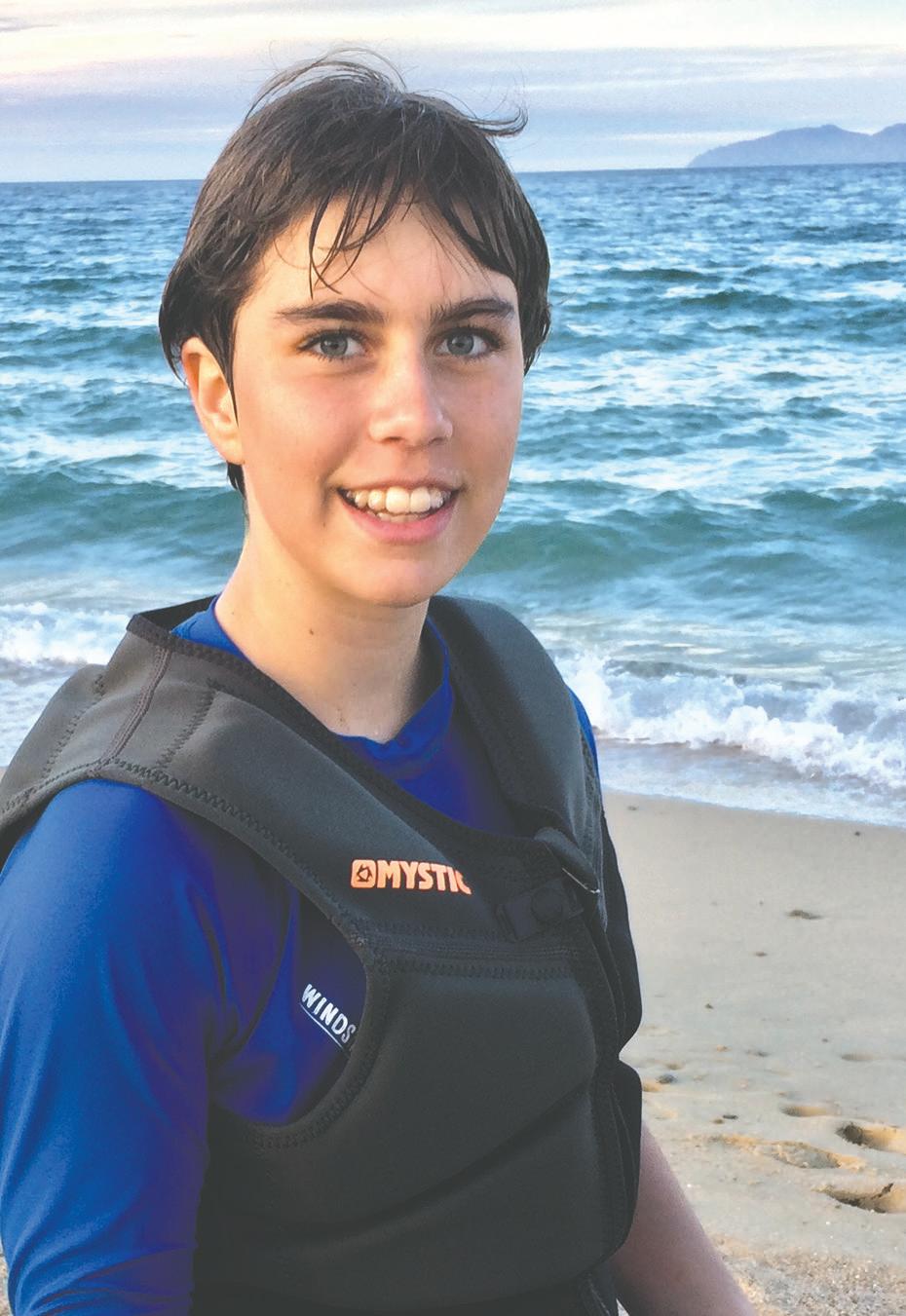


LAUNDRY from page 5
that restaurants require to open shop, turning them into eateries is relatively straightforward.”
The Atlantic published a story on the topic that spoke to a national trend in the death of laundromats, especially in major metropolitan areas, such as Los Angeles, Chicago and San Francisco, where new housing developments often cater to wealthy residents with amenities like in-unit washers and dryers. The piece cited dwindling profits for laundromat owners, exacerbated by high costs associated with repairing aging machines and increases in water and sewage expenses, as contributing to the sector’s decline. According to Buzzfile, an online company information database, Potrero Hill Coin Laundry generated an estimated $64,820 in annual revenues and employed two people.
While there are other clothescleaning options for Hill residents, a neighborhood laundromat isn’t among them. Laundry Locker, a dry cleaning and laundry service that operates 24 hours per day, seven days a week, has numerous City locations, including a few coin operated machines at its Folsom and 22nd streets location, and kiosks in office and residential buildings. The enterprise provides full service wash & fold – washing, drying and folding – dry cleaning and shoe repair, with home delivery offered. Customers can choose from three plans, ranging from $46.99 per month for 30 pounds of laundry to $104.99 for 90 pounds.
“We’ve had pretty steady growth in business over the past year,” said Aura
Moser, customer service representative, Laundry Locker, “We’ve added more kiosks in new buildings. There are no plans to add more coin operated machines.”
Vermont Cleaners, at 600 Vermont Street, lacks coin operated machines but provides full service wash & fold, including home delivery. According to owner, Benson Xu, the business is a Certified Green Cleaner, only using naturally-derived ingredients in cleansing products.
Mulberry’s Garment Care, located in Mission Bay, provides pickup and delivery service to Potrero Hill. Mulberry’s offers dry and wet cleaning, alterations and shoe repair, among other services. Prices start at $2.69 per garment for wash & fold.
An option unbounded by neighborhood geography is Rinse. Operating in five major U.S. cities, including San Francisco, customers can schedule laundry service through a mobile application, text message or the company’s website. Once scheduled, home pickup and delivery service is available for dry cleaning, wash & fold – starting at $1.75 per pound – and hang-dry laundering.
Alternatives similar to Rinse include Instawash and Sudzee. Instawash serves most of the City, including the Hill, and is also based on a mobile application. Customers schedule service through the app; a valet arrives at the client’s home to collect the laundry. Cleaned clothes are dropped off within 24 hours, at which time payment is due, starting at $1.50 for wash & fold. After registering for an account online, Sudzee patrons leave their dirty clothes in a locked bag, provided by the busi-
ness, on their doorstep. After returning home from work, the clean garments should be waiting at the front door. Prices for Sudzee service start at $0.97 per pound, plus an $1.01 per pound delivery charge for Hill residents.
For those seeking coin-operated machines, adjacent neighborhoods offer more options, especially the Mission. Burbujas Text-o-Mat has two locations with self-service laundry machines at 2899 24th Street and 3157 Mission Street. Prices for coin machines vary. Generally, dryers cost $0.25 for six minutes; washers clean 30 pounds of clothing for $4.50. Free fabric softener is available. Full service wash & fold service start at $1.15 per pound.
Those willing to lug their dirty clothes to the heart of the Mission can try a new laundromat at 2401 Mission Street, Laundr é. It’s a destination for patrons who seek to do their garment cleansing in a comfortable gathering space equipped with coffee bar amenities. The self-service machines boast energy efficiency and speedy cleaning times. Free soap is thrown in. A short food menu is available alongside cafe beverages.
A similar laundromat-cafe duo South of Market, Brainwash, closed last year. Other relatively nearby establishments include Lily’s Laundromat, 2204 Bryant Street, Fiesta Laundromat, 898 South Van Ness Avenue, and Bubbles & Beans Laundromat, 3547 24th Street.
low elevation and 120,000 low income housing residents. “There is both a so -
cial and physical vulnerability there,” he said. “It involved looking at other aspects of the community and what the community would like to see and combine them into something larger. How coastal protection, improvement of infrastructure, improvement of open spaces, educational opportunities and commerce work together over time.”
One of the comparable aspects of Islais, said Bry, is that there’s an economically disenfranchised neighborhood to the south, Bayview, with a high concentration of poverty and public housing. “We would be remiss not to consider the Bayview community, particularly in that it hasn’t benefited from other upgrades and improvements to the City,” he said.
Over the next two months the team will work with community groups and municipal officials to determine how short-term fixes to erosion can be compatible with long-term desires, such as keeping jobs and improving public access to Islais Creek’s shoreline. Then the team will combine its own creative ideas with existing studies, including those conducted by San Francisco Planning Department, San Francisco Bay Area Planning and Urban Research Association (SPUR), Port of San Francisco and San Francisco Public Utilities Commission (SFPUC).
There’s a high concentration of government-controlled property around Islais, including sites owned by SFPUC, San Francisco Municipal Transportation Agency, Port and Caltrain. In its preliminary proposal, the team called for a strategy of protection
ISLAIS continues on page 23

CLEANING PROFESSIONAL since 1986. Offices, apartments, homes, and buildings. Roger Miller 415-794-4411 References given with bid.
Gorgeous, rustic, Muir Beach space and stunning Mission Dolores home available for day rentals. Perfect for six to 10 people engaged in retreats of all kinds: writing, yoga, teambuilding, strategy sessions. $1,500 to $3,000 a day. Editor@potreroview.net; 415.643.9578.
Walking distance to the beach, with the crashing waves visible and audible from the place. Includes kitchenette and lovely patio. $175/weekdays; $200/ weekends; $250/holidays. Editor@ potreroview.net; 415.643.9578.
Walking distance to the beach, with the crashing waves visible and audible from the place. Three bedrooms, two baths, with a lovely deck. Minimum two nights: $450/weekdays; $500/ weekends; $550/holidays. Editor@ potreroview.net; 415.643.9578.
Got something you need to sell? Have a service you provide? Our Classified Ad section is just the place for you! Cost: Each classified ad is $25 for up to 200 characters, including spaces. A 20-percent discount will be provided for ads paid for six months in advance. Payment, and/or corrections, must be received by the 18th of each month for the ad to appear in the following month’s issue. Please email all classified ads to office@potreroview.net
Carolyn Anaya
March 9, 1945 – September 21, 2017
Two quite important family members were omitted from the obituary that appeared in the February 2018 View. Carolyn is survived by her daughter, Shari Anaya Mendoza, and her son Richard Anaya. Carolyn deeply loved her children, and always wanted the best for them.
300 KANSAS from page 4
the structure to have a positive and optimistic presence on the site, imbuing a welcoming feel against the backdrop of Highway 101 just to the west.
The developer has met with the Potrero Boosters development committee, and plans to hold meetings with other groups to garner their feedback. Frank Gilson, Potrero Dogpatch Merchants Association president, hopes to meet with Group I representatives, and expressed a desire that opportunities for small businesses be created in the new space.
Chang emphasized that the development team has just begun the conceptual planning process, and that it could be up to two years before entitlements are gained. “We met with the Boosters and gave a presentation back in December,” said Chang. “It went very well, and people gave some very thoughtful comments about the conceptual plan. We definitely want to hear from more folks in the neighborhood.”
J.R. Eppler, Potrero Boosters president, and a candidate for District 10 Supervisor, anticipates that a followup meeting with the project team will be scheduled once changes have been made to the preliminary design. Development committee members praised the concrete podium, transparent mezzanine and use of translucent material on the building’s north and south facades. However, given the height and associated visibility from much of Potrero Hill, some want more attention paid to the roof treatment. Overall, the committee found the east and west facades to be quite dark, and communicated that they were hoping for a brighter appearance. The Boosters requested that the amount of vehicle parking provided in the garage drop from 100 spots to 61, given the project’s proximity to public transit.
“We’ll continue to work with them on the design,” said Eppler. “I’m optimistic that the committee can work out the details. Another committee meeting will be held in March and then there’ll be a presentation to the general membership in April.”
Eppler said that he and other Boosters members are appreciative of
the 100 percent PDR use for the building, and surmised that the main tenant could possibly be a medical testing and device company. A request was made during the Boosters meeting that a street-level, smaller, maker space, as well as room for the arts, be provided along Kansas and 16th streets. According to Eppler, it’s important to incorporate a passenger loading/unloading zone on Kansas Street in addition to the loading/unloading zone for building operations that’s etched into the plans for Vermont Street. He said that increased street-level activity will help make the area feel safer.
WATERFRONT from page 17
don’t always work collaboratively. At the plan’s unveiling at Dogpatch Studios, District 10 Supervisor Malia Cohen recalled when she took office eight years ago even the Dogpatch Neighborhood Association and Potrero Boosters didn’t get along so well. “In the past people were very siloed in their thinking, and the City in fact was very siloed in their planning.” She added that as the area develops it’s important to have the necessary infrastructure in place.
“This plan is a great model for how we can work together,” John Rahaim, San Francisco Planning director, added.
A copy of the plan can be viewed at http://sf-planning.org/central-waterfront-dogpatch-public-realm-plan
The Airport Commission has commenced the RFP process for Airport Concierge Service Lease. This Lease is for the operation of VIP and concierge-style services at San Francisco International Airport. The Minimum Annual Guarantee (MAG) for this Lease is $10,000.00.
The term is three years with one two-year option to extend exercisable at the Airport Commission’s discretion. Annual Rent shall be the higher of the Minimum Annual Guarantee or 8% of Gross Revenues.
An Informational Conference will be held on February 14, 2018, at 10:30 a.m. PST at the SFO Business Center, 575 N. McDonnell Road, Third Floor, Suite 3-313, Aviation Management’s Conf. Room, at SFO. Small, local and disadvantaged businesses are encouraged to participate.
Please see website http://www.flysfo.com/business-at-sfo/current-opportunities for additional information or call John M. Reeb, Sr. Principal Property Manager, (650) 821-4512.
The Youth Commission is a body of 17 San Franciscans between the ages of 12 and 23. Created by the voters in 1995 through a charter amendment, the commission is responsible for advising the Mayor and Board of Supervisors on policies and budgets related to youth. The commission is also charged with providing comment, recommendation, and feedback on all proposed laws that affect youth before the Board takes final action.
Commissioners work diligently to connect young people with one another, develop leadership skills and understanding of government, and make positive policy changes.
The commission meets on the first and third Monday of every month at 5:15pm in room 416 of City Hall. Their standing issue-based committees meet regularly in the Youth Commission office, City Hall Room 345.
Visit our website www.sfgov.org/yc, email YouthCom@sfgov.org, or call (415) 554-6446
The annual San Francisco Summer Resource Fair will take place Saturday, March 10 11am-3pm at the County Fair Building in Golden Gate Park. The Summer Resource Fair will feature 150 summer programs, camps, classes and other services for children and youth from age 3 to 18. Many of the programs are free or low cost, and may enroll participants on the spot. The Fair is an excellent resource for families to start planning their summer, and it is a lot of fun: the Rec & Park Department will set up a KidZone with games, arts and crafts, a climbing wall, and other fun activities, Play-Well TEKnologies will host a massive Lego building project, and the SF Public Library will bring their Bookmobile and host a book giveaway.
Find out about PrEP, a daily pill to prevent HIV, through an automated mobile texting conversation. You can learn about PrEP, have concerns addressed, and even find out where you can get PrEP! You can also refer friends to find out about PrEP through the texting service. Text “CITYPREP” to 213-33 (messaging and data rates apply).
Email prephelp@sfdph.org or visit http://sfcityclinic.org/services/prep/asp for more information.
This program is sponsored by the Population Health Division of San Francisco Department of Public Health (SFDPH).
and retreat. In terms of withdrawal, it advised returning 300 acres of filledin marshland to the creek, mostly to the south and west, to “create green corridors that enhance biodiversity and improve water quality.” Creek expansion would mean that I-280 would travel over water instead of serving as the creek’s eastern border.
The proposal acknowledged the Planning Department’s concept of turning the highway into a boulevard further north, and advised that, should that come to fruition, the highway platform traversing through Bayview could be turned into a skydeck for pedestrians and bicyclists heading downtown or to Caltrain.
Despite a loss of land caused by creek expansion, the team believes that private property owners in the area can be mollified by creating an additional five million square feet of industrial space along the northern edge, by consolidating existing industry through denser construction. Moving the treatment plant from Phelps Street to underutilized Piers 90-94 would also open space for housing and commercial development. Those two measures could address Bayview residents’ concerns about keeping jobs and eliminating polluting industry from what’s now a mixed-use neighborhood. The piers could house both the plant and a park that, connected to Heron’s Head Park to the south, could rival Golden Gate Park in terms of size.
Moving the plant is unlikely, at least before 2040, given that recent past efforts to do so have failed. The facility,
built in 1952, is slated for a $1.3 billion renovation. Last month, SFPUC announced that “After years of input and involvement from Bayview residents like you, this year we will start major upgrades at the Southeast Treatment Plant.” Still, an in-depth study of Islais Creek conducted a decade ago by SPUR mentioned the piers as a possible relocation site for it. The area, known as the Backlands, is being evaluated by the Port as an eco-industrial park, potentially housing biodiesel and recycling businesses.
According to Derek Jansen, Resilient spokesperson, the Challenge studies reflect a collaborative effort with local officials, and that by bringing new expertise with fresh ideas to the issues the result should be an asset to the community.
The other areas chosen by Resilient for design plans include San Rafael; San Pablo Bay; Vallejo and Mare Island; North Richmond; San Leandro Bay; South San Francisco; Alameda Creek; East Palo Alto, Sunnyvale and Mountain View; and a regional resilience for all Bay Area counties.











